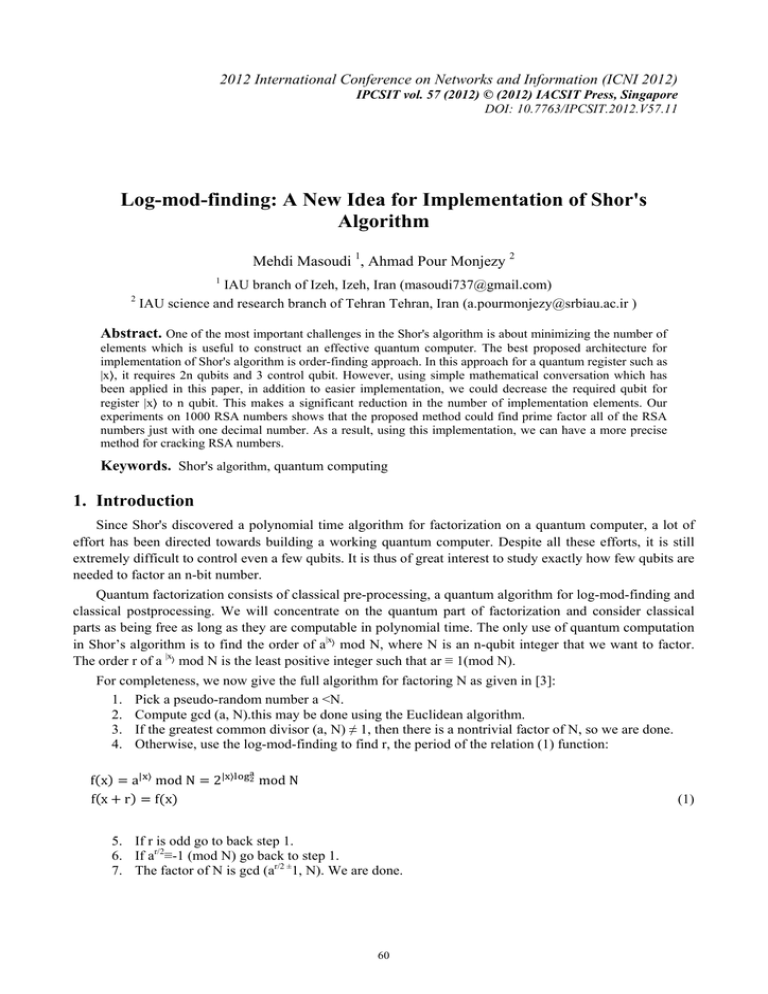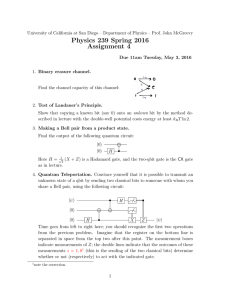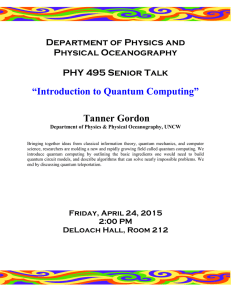Log-mod-finding: A New Idea for Implementation of Shor's Algorithm Mehdi Masoudi
advertisement

2012 International Conference on Networks and Information (ICNI 2012)
IPCSIT vol. 57 (2012) © (2012) IACSIT Press, Singapore
DOI: 10.7763/IPCSIT.2012.V57.11
Log-mod-finding: A New Idea for Implementation of Shor's
Algorithm
Mehdi Masoudi 1, Ahmad Pour Monjezy 2
1
2
IAU branch of Izeh, Izeh, Iran (masoudi737@gmail.com)
IAU science and research branch of Tehran Tehran, Iran (a.pourmonjezy@srbiau.ac.ir )
Abstract. One of the most important challenges in the Shor's algorithm is about minimizing the number of
elements which is useful to construct an effective quantum computer. The best proposed architecture for
implementation of Shor's algorithm is order-finding approach. In this approach for a quantum register such as
|x⟩, it requires 2n qubits and 3 control qubit. However, using simple mathematical conversation which has
been applied in this paper, in addition to easier implementation, we could decrease the required qubit for
register |x⟩ to n qubit. This makes a significant reduction in the number of implementation elements. Our
experiments on 1000 RSA numbers shows that the proposed method could find prime factor all of the RSA
numbers just with one decimal number. As a result, using this implementation, we can have a more precise
method for cracking RSA numbers.
Keywords. Shor's algorithm, quantum computing
1. Introduction
Since Shor's discovered a polynomial time algorithm for factorization on a quantum computer, a lot of
effort has been directed towards building a working quantum computer. Despite all these efforts, it is still
extremely difficult to control even a few qubits. It is thus of great interest to study exactly how few qubits are
needed to factor an n-bit number.
Quantum factorization consists of classical pre-processing, a quantum algorithm for log-mod-finding and
classical postprocessing. We will concentrate on the quantum part of factorization and consider classical
parts as being free as long as they are computable in polynomial time. The only use of quantum computation
in Shor’s algorithm is to find the order of a|x⟩ mod N, where N is an n-qubit integer that we want to factor.
The order r of a |x⟩ mod N is the least positive integer such that ar ≡ 1(mod N).
For completeness, we now give the full algorithm for factoring N as given in [3]:
1. Pick a pseudo-random number a <N.
2. Compute gcd (a, N).this may be done using the Euclidean algorithm.
3. If the greatest common divisor (a, N) ≠ 1, then there is a nontrivial factor of N, so we are done.
4. Otherwise, use the log-mod-finding to find r, the period of the relation (1) function:
f x
f x
a| ⟩ mod N
r
f x
2|
⟩
mod N
(1)
5. If r is odd go to back step 1.
6. If ar/2≡-1 (mod N) go back to step 1.
7. The factor of N is gcd (ar/2 ±1, N). We are done.
60
Fig. 1: Shor’s algorithm flow chart
2. The Circuit
In log-mod-finding approach instead of calculating the amount of a|x⟩ mod N, 2| ⟩
mod N is
calculated. In order to understand easily, four stages have shown in Figure 2. In the first stage, quantum
register |x⟩ is multiplied by the integer, and then two power of the result be calculated, after this, mod N is
calculated and then using the quantum furrier transform, The frequency of repetition was obtained and
delivered to the classical process to do the rest algorithm.
Fig. 2: quantum factorization stages
2.1.
The multiplier gate
Considering the expression (2) the multiplier, integer and decimal part of Log are considered as an
integer and multiplied by the quantum register |x⟩ and then the number of decimal qubits for the intended
destination has to be removed low significant Results qubits. Whatever, the number of qubit which allocated
to the decimal number be more, circuit has more precision in response. Also simulation for 1000 RSA
number showed this circuit funded RSA factors successfully just with one decimal number.
(2)
a | ⟩ 2| ⟩
2| ⟩ I.F 2 I.F
For implementing the multiplier circuit of reversible HGN and PG gate (Figure 3) is used. A multiplier
circuit by these gates has been implemented by multiplying the minimum components gates for multiplying
operation.
Fig. 3: Reversible HNG and PG gate
61
Fig. 4: Partial products in a 4*4 multiplication
Fig. 5: multiplier gate
The Figure 3 is a four qubits multiplier. These components as MUL (Figure 5) and introduce it used to
multiplied by the quantum register |x⟩ and the IF (integer and decimal part of Log ), the number of qubits
which has been consider in for decimal, it is necessary to remove the given low significant result of
multiplying.
2.2.
The decoder gate
After multiplying |x⟩*IF, the two power the result must be calculated. We know that when the two power
a number such as z, (z +1)th result qubit will be one. This behaviour is similar to the output of a decoder;
using a quantum decoder these components can easily be implemented. Figure 6 shows an example of
decoder 2 to 4 which has been implemented by CNOT and Toffoli gate.
Fig. 6: partial products in a 2 to 4 quantum decoder
2.3.
The mod gate
Now, a circuit is needed to calculate mod N after result of decoder. In this circuit conditional phase
shifter has been used, this gate if the control and target qubit equal 1 phase change equals to
(k is
equivalent to phase shift amount which has shown on conditional phase shifter) occurred on target qubit.
If the controlled gate apply for quantum number |a⟩ and Fourier |b⟩ the result will be equal to Fourier | a⟩
+ | b⟩ of the two numbers, and if this action reverse on number |a⟩ and Fourier |b⟩ the result will be Fourier |
a⟩ - | b⟩. so these component can be used for next operation according to the bars located at the left and right
of these, any one can distinguish a component from other.
62
Fig.7: adder and subtracter gate
To obtain the Mod components ФMOD (Figure 8) has been introduce, this component can subtract the
first number from the second, due to controlling of valuable qubits if the result will be negative, the
subtraction number will be added the first number again. Using this component to calculate the mod amount
of first stage amount of 2 N will be subtracted from 2| ⟩
and again if the result will be negative in
sign the same amount would be added to it. This action will be done till the amount of 2 N is acquired,
mod N.
then at the last stage the output would be 2| ⟩
{
{
Fig. 8: Implementation ФMOD gate
Using this component, as is shown in Figure 9 together, will be placed besides the obtained result from
the mod series will be taking the quantum Fourier transform, r come from it.
Fig. 9: mod gate
3. The log-mod-finding circuit
According to the previous components the quantum part can be implement as figure 10, this circuit has
there input, the first of them is quantum register of |x⟩ which intern is zero modes that has been transfer from
Hadamard gates till a mode of superposition include all of numbers can be seen. The second input is equal to
the amount of I, which intern is equal to integer part of Log . This input is obtained by classical process and
63
delivered to quantum part. The third input is F which in turn is equal to integer part of Log , if the circuit
output subjected to quantum Fourier transform the result will be equalled to 2| ⟩
mod N period or r, this
result is a classical number. Then classical part of this number can be received and according to the
1, N will be calculated. If the obtained numbers is the factors N, the algorithm will be
algorithm gcd a
ended otherwise, classical part can continue using new amount of algorithm until the prime number will be
found.
Fig. 10: log- mod- finding circuit
4. Conclusion
In this paper, we proposed utilizing 2| ⟩
expression instead of a| ⟩ in the fourth step of Shor's
algorithm. This simple change could reduce the number of qubits into n for a determined register x. Also it
could outperform existing methods in terms of number of gates significantly. The simulations assert that the
proposed circuit cracked 1000 of RSA numbers successfully just with one decimal number.
5. References
[1] S. Beauregard, “Circuit for Shor’s algorithm using 2n+3 qubits, Quantum Information and Computation,” quantph/0205095v3, 2003 pp 175–185.
[2] P. Shor, “Polynomial-time algorithms for prime factorization and discrete logarithms on a quantum computer,”
SIAM J. Comp., 26, 1997 pp. 1484-1509.
[3] P. Barrera, A. Calabro,L. Fortuna, D. Porto, “A new method for implemention gate operation a quantum factoring
algorithm, ” Circuits and Systems, ISCAS. 2003, pp 777- 780.
[4] M. Haghparast, S. j. Jassbi, K. Navi, Design of a Nover reversible multiplier circuit using HNG gate in
nanotechnology, World Appl. Sci. j, 3(6), 2008, pp 974-978.
[5] R. zhou, Y. Shi,J. Cao, H. Wang, “Comment on Design of a Novel reversible multiplier circuit usin HNG Gate in
nanotechnology, ” World Appl. Sci. j,10(2) , 2010,pp 161-165.
[6] G. Draper, “Addition on a quantum computer, ” quant-ph/0008033v1, 2000.
[7] M. Nakhara, T. ohmi, “quantum computing from linear algebra to physical realizations, ” Taylor & Francis
book,ISBN-13:978-0-7503-0983-7,2008.
[8] X. Fu, W. Bao, C. Zhou, “Design and Implementation of Quantum Factorization Algorithm, ” Proceding 3th of
the IEEE conference Intelligent Information Technology and Security Informatics(IITSI), April 2010, pp. 748 –
752.
[9] R. Cleve and J. Watrous (2000), Fast parallel circuits for the quantum Fourier transform, Proceedings 41st Annual
Symposium on Foundations of Computer Science (FOCS’00), pp. 526-536.
[10] M. Mosca and A. Ekert (1999), the hidden subgroup problem and eigenvalue estimation on a quantum computer,
Lecture Notes in Computer Science, 1509, pp. 174-188.
[11] S. Parker and M.B. Plenio (2000), efficient factorization with a single pure qubit and logN mixed qubits, Phys.
Rev. Lett., 85, pp. 3049-3052.
[12] A. Barenco, C. Bennett, R. Cleve, D.P. DiVincenzo, N. Margolus, P. Shor, T. Sleator, J.A. Smolin, and H.
Weifurter (1995), Elementary gates for quantum computation, Phys. Rev. A, 52, pp. 3457-3467.
[13] D. Beckman, A.N. Chari, S. Devabhaktuni, and J. Preskill (1996), efficient networks for quantum factoring, Phys.
Rev. A, 54, pp. 1034- 1063.
[14] L.M.K. Vandersypen, M. Steffen, G. Breyta, C.S. Yannoni, M.H. Sherwood, and I.L. Chuang (2001),
Experimental realization of Shor’s quantum factoring algorithm using magnetic resonance, Nature, 414, pp. 883887.
64







